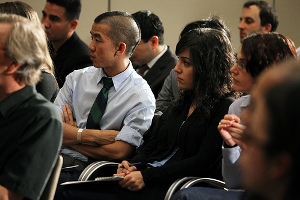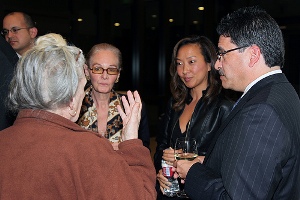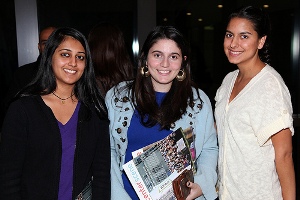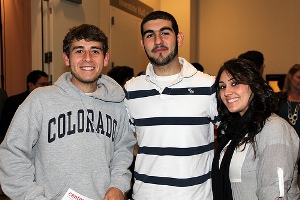
Every 10 years, the Census Bureau performs its comprehensive count of the American population, a tally that determines the crucial question of Congressional representation, among other things. And every 10 years, controversy erupts.
The 2010 Census will be no different, explained Arturo Vargas to the crowd at the California Endowment.
“This is one controversy we have seen in every Census since at least 1970 – efforts to not include either non-citizens or the undocumented,” said Vargas, who serves as Executive Director of the National Association of Latino Elected and Appointed Officials.
Vargas joined fellow panelists Jennifer Lee of UCI, Paul Ong of UCLA, Jorge-Mario Cabrera of the Coalition for Humane Immigrant Rights Los Angeles, and moderator Steve Padilla of the Los Angeles Times to explore the intricacies of this year’s Census, the Bureau’s long and sometimes strange history, and why a count isn’t just a count.
Why the Census matters
The Census’s latest controversy came earlier this month, when Sen. David Vitter, a Republican from Louisiana, tried to block the Census from counting noncitizens. The Senate blocked the plan, Vargas said, asking, “Doesn’t this guy read the Constitution?”
 The count raises such ire, Vargas noted, because it is about “two things nobody freely gives up”: power and money. As Ong explained, states grow or lose population at different rates, requiring adjustments of Congressional seats for fair representation. “That’s the core mandate” of the Bureau according to the Constitution, Ong said. Beyond that, the Census helps enforce voting rights by collecting information on racial composition and gender; employment, income, housing, and other statistics help federal, state and local governments allocate public resources. The federal government alone, according to one estimate, distributes $440 billion to state and local governments based in some part on Census information, Vargas said. State and local governments also allocate additional money based on the information – meaning that for everyone who isn’t counted, governments lose money.
The count raises such ire, Vargas noted, because it is about “two things nobody freely gives up”: power and money. As Ong explained, states grow or lose population at different rates, requiring adjustments of Congressional seats for fair representation. “That’s the core mandate” of the Bureau according to the Constitution, Ong said. Beyond that, the Census helps enforce voting rights by collecting information on racial composition and gender; employment, income, housing, and other statistics help federal, state and local governments allocate public resources. The federal government alone, according to one estimate, distributes $440 billion to state and local governments based in some part on Census information, Vargas said. State and local governments also allocate additional money based on the information – meaning that for everyone who isn’t counted, governments lose money.
What 2010 Holds
This year’s Census will differ from previous years in a few significant ways, the panelists noted. Ong pointed out that everyone will receive a short form rather than either a short or long form (the long versions once went out to one in six households). The detailed information once collected by the long form is now done through a separate count – the American Community Survey – an ongoing effort performed monthly that tallies 2.5 percent of the population ever year and provides timelier information. (As Vargas noted, 250,000 households will still receive two forms in March and in April, because the Census and the American Community Survey will occur simultaneously.)
Cabrera added that, for the first time, Census forms will be bilingual. About 13 million households will receive Census forms in Spanish and English, according to their surnames and whether they live in an area where 20 percent of the population speaks Spanish. It’s crucial for the country when immigration is a major domestic issue, Cabrera said. Census forms will also be printed in six additional languages, with 56 language assistance guides available, Vargas added. Bilingual forms weren’t used previously in part because the Census was sensitive to criticism from families that spoke English but received bilingual forms. And many growing pockets of Spanish-speaking immigrants still won’t receive the forms, if they make up less than 20% of their community – a likely occurrence in Southern states were immigrant populations are booming but still small, Lee noted.
 Despite this effort to count Latino immigrants, many are boycotting the Census, Cabrera said, because of the lack of movement on immigration reform. “By counting me, you’ll get money, you get political clout, but you don’t give me anything back,” Cabrera said, explaining the logic of the protest while noting that his organization is “vehemently against a boycott because we feel it is counterproductive.”
Despite this effort to count Latino immigrants, many are boycotting the Census, Cabrera said, because of the lack of movement on immigration reform. “By counting me, you’ll get money, you get political clout, but you don’t give me anything back,” Cabrera said, explaining the logic of the protest while noting that his organization is “vehemently against a boycott because we feel it is counterproductive.”
And while undercounting is all but inevitable, Ong said, the real worry is “differential undercounting” – where certain populations are overrepresented, and others are underrepresented. For instance, unofficial housing units in Los Angeles tend to be undercounted. California could stand to lose (or at least not gain) Congressional representation for the first time ever. States in the Midwest stand to lose as well, while Southern states stand to gain. During a recession, the Census may also miss those who are temporarily homeless and living with family or friends. And the undocumented may not fill out forms because of fear.
Counting and creating race
Despite distrust of the Census by the undocumented, the Bureau is steadfast in its assurances of confidentiality, Ong said. The only instance in which they released confidential information was data on Japanese Americans, tens of thousands of whom were subsequently interned during World War II. Vargas emphasized that the Census Bureau now can’t release such information on, for instance, Arab Americans, even under the powers of the PATRIOT Act. The Census also recently appointed an ombudsman on privacy.
 The Census’ history is more complicated than a single past controversy would suggest, as Lee noted. Racial and ethnic categorization have transformed over the centuries according to Census terms. In 1790, the Census codified the Three-Fifths Compromise, which counted black slaves as three-fifths a person. In 1850, the count included a tally of “mulattos.” In 1890, in ever finer racial parsing, the Census added “octoroon” and “quadroon” to capture precise racial make-up. By 1930, the extent of racial mixing made such categorization too difficult, and the one-drop rule won. And until 1970, Americans didn’t mark their own race – Census evaluators did it for them. In part because of this history, “Americans have become very attuned to identifying blackness,” Lee said.
The Census’ history is more complicated than a single past controversy would suggest, as Lee noted. Racial and ethnic categorization have transformed over the centuries according to Census terms. In 1790, the Census codified the Three-Fifths Compromise, which counted black slaves as three-fifths a person. In 1850, the count included a tally of “mulattos.” In 1890, in ever finer racial parsing, the Census added “octoroon” and “quadroon” to capture precise racial make-up. By 1930, the extent of racial mixing made such categorization too difficult, and the one-drop rule won. And until 1970, Americans didn’t mark their own race – Census evaluators did it for them. In part because of this history, “Americans have become very attuned to identifying blackness,” Lee said.
Also in 1930, “Mexican” was listed as a racial category, until Latino civil rights advocates demanded it be nixed because it implied Mexicans were not white. Today, Americans are asked their race – white, black, Asian, native American or some combination – and their ethnicity, where they can identify whether they are Hispanic, and from what country. Half of Latinos do not identify in any racial category, Vargas said, and check “other,” which the Census automatically re-categorizes among the other racial categories. Lee added that half to 60 percent of Hispanics racially identify as white, unless presented with “Hispanic” as a racial group alongside white. In that case, one study found, only 13.7 percent would identify as white. As Ong said, “The Census has implicitly created a new racial category – non-Hispanic white.” He added that the Census also implies, incorrectly, that various Asian ethnicity and nationalities are “races”, by grouping them under the Asian racial category. (The listing of countries, however, was a victory in 1970 for those who argued that Asians don’t think of themselves as “Asian.”)
2010 and 2020
 There are many questions the Census still doesn’t ask. Religious affiliation is untouchable, as Padilla noted, because the separation of church and state means the question has no legislative purpose, as all Census questions must. Sexual orientation is still off the books – some seek it for informational purposes, others fear the privacy issues, and still others don’t want differences in orientation legitimized by the Census. More practically, Vargas pointed out, the survey still doesn’t ask about Internet access. The latest Census must be delivered to the president on December 31, 2010 – after forms are mailed, and after enumerators visit homes – and will surely undercount, and not ask all the right questions.
There are many questions the Census still doesn’t ask. Religious affiliation is untouchable, as Padilla noted, because the separation of church and state means the question has no legislative purpose, as all Census questions must. Sexual orientation is still off the books – some seek it for informational purposes, others fear the privacy issues, and still others don’t want differences in orientation legitimized by the Census. More practically, Vargas pointed out, the survey still doesn’t ask about Internet access. The latest Census must be delivered to the president on December 31, 2010 – after forms are mailed, and after enumerators visit homes – and will surely undercount, and not ask all the right questions.
Cabrera offered simple advice, at least, for those who fear the count: “If you don’t want anyone knocking on your door, fill out your survey when you receive it in the mail.”
Watch the video here.
See more photos here.
*Photos by Aaron Salcido.




Send A Letter To the Editors